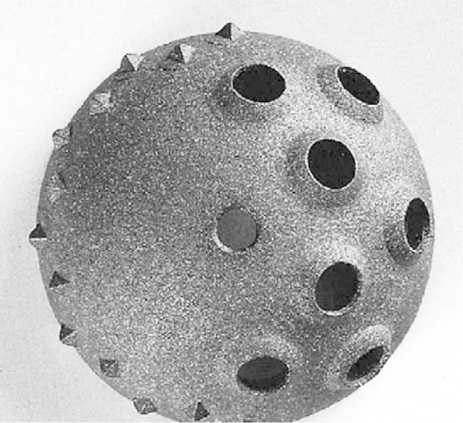J Korean Hip Soc.
2010 Jun;22(2):143-150. 10.5371/jkhs.2010.22.2.143.
Analysis of Failure Cause of Acetabular Components Among Total Hip Replacement Arthroplasties Using RB Wagner Acetabular Cup
- Affiliations
-
- 1Department of Orthopaedic Surgery, College of Medicine, Inje University, Haeundae Paik Hospital, Busan, Korea. neomed95@naver.com
- 2Department of Orthopaedic Surgery, College of Medicine, Inje University, Busan Paik Hospital, Busan, Korea.
- KMID: 1461136
- DOI: http://doi.org/10.5371/jkhs.2010.22.2.143
Abstract
- PURPOSE
The purpose of this study was to analyze the cause of failure of acetabular component cases after metal-on-metal primary total hip arthroplasty using RB Wagner acetabular cup.
MATERIALS AND METHODS
Between January 1993 and January 2005, we retrospectively studied failure cause of 27 patients who underwent acetabular revision surgery among 468 consecutive cementless total hip arthroplasties using RB Wagner acetabular component. The duration of primary arthroplasty to revision ranged from 5.1 years to 11.5 years (mean 9.2 years). The clinical evaluation was performed using preoperative and last follow-up modified Harris hip scores. The radiological evaluation was performed in terms of the stability, such as inclination, anteversion, cup size, acetabular bone coverage, osteolysis, radiolucency and gap.
RESULTS
The average Harris hip scores was 49.6 preoperatively and 91.3 at the most recent follow-up. In revision cases, the score was 41.2 to 51.7. Among 468 cases, 27 patients underwent revision surgery (7%, 27/468) and there was no osseointegration in all cases. The radiological evaluation in revision cases revealed inclination (46.04+/-5.328, p=0.0031), anteversion (14.14+/-2.95, p=0.584), cup size (54 mm+/-2.5, p=0.042) and acetabular bone coverage (67.9%+/-4.77, p=0.003). Focusing on the relation between disease entities, there was relatively high risk in patients with hip dysplasia (Fisher's exact test, p=0.0095).
CONCLUSION
Although Wagner acetabular cup relatively showed as high survival rate as 93%, failure rate is significantly high in dysplastic hip patients.
MeSH Terms
Figure
Reference
-
1. Wiles PW. The surgery of the osteoarthritic hip. Br J Surg. 1958. 45:488–497.
Article2. Chan FW, Bobyn JD, Medley JB, Krygier JJ, Yue S, Tanzer M. Engineering issue and wear performance of metal on metal hip implants. Clin Orthop Relat Res. 1996. 333:96–107.3. Renawat CS, Deshmukh RG, Peters LE, Umlas ME. Prediction of the long-term durability of all-polyethylene cemented sockets. Clin Orthop Relat Res. 1995. 317:89–105.4. Dowdy PA, Rorabeck CH, Bourne RB. Uncemented total hip arthroplasty in patients 50 years of age or younger. J Arthroplasty. 1997. 12:853–862.
Article5. Fye MA, Huo MH, Zatorski LE, Keggi KJ. Total hip arthroplasty performed without cement in patients with femoral head osteonecrosis who are less than 50 years old. J Arthroplasty. 1998. 13:876–881.
Article6. Harris WH. Traumatic arthritis of the hip after dislocation and acetabular fractures: treatment by mold arthroplasty. An end-result study using a new method of result evaluation. J Bone Joint Surg Am. 1969. 51:737–755.
Article7. Schmalzried TP, Harris WH. The Harris-Galante porous-coated acetabular comoponent with screw fixation. Radiographic analysis of eighty-three primary hip replacements at a minimum of five years. J Bone Joint Surg Am. 1992. 74:1130–1139.
Article8. Kim SY, Kyung HS, Ihn JC, Cho MR, Koo KH, Kim CY. Cementless Metasul metal-on-metal total hip arthroplasty in patients less than fifty years old. J Bone Joint Surg Am. 2004. 86-A:2475–2481.
Article9. DeLee JG, Charnley J. Radiological demarcation of cemented sockets in total hip replacement. Clin Orthop Relat Res. 1976. 121:20–32.
Article10. Gruen TA, McNeice GM, Amstutz HC. "Modes of failure" of cemented stem-type femoral components: a radiographic analysis of loosening. Clin Orthop Relat Res. 1979. 141:17–27.11. Charnley J. Total hip replacement by low-friction arthroplasty. Clin Orthop Relat Res. 1970. 72:7–21.
Article12. Morscher E, Schmassmann A. Failures of total hip arthroplasty and probable incidence of revision surgery in the future. Calculations according to a mathematical model based on a ten years' experience in total hip arthroplasty. Arch Orthop Trauma Surg. 1983. 101:137–143.
Article13. Bra-nemark PI, Zarb GA, Albrektsson T, Rosen HM. Tissue-integrated prostheses. Osseointegration in clinical dentistry. Plastic and Reconstructive Surgery. 1986. 77:496–497.
Article14. Albrestsson T, Albrestsson B. Osseointegration of bone implants. A review of an alternative mode of fixation. Acta Orthop Scand. 1987. 58:567–577.
Article15. Uhthoff HK. Mechanical factors influencing the holding power of screws in compact bone. J Bone Joint Surg Br. 1973. 55:633–639.
Article16. Schatzker J, Horne JG, Sumner-Smith G. The effect of movement on the holding power of screws in bone. Clin Orthop Relat Res. 1975. 111:257–262.
Article17. Bruijin JD, Seelen JL, Feenstra RM, Hansen BE, Bernoski FP. Failure of the Mecring screw-ring acetabular component in total hip arthroplasty. A three to seven-year follow-up study. J Bone Joint Surg Am. 1995. 77:760–766.
Article18. Linder L, Carlsson A, Marsal L, Bjursten LM, Branemark PI. Clinical aspects of osseointegration in joint replacement. A histological study of titanium implants. J Bone Joint Surg Br. 1988. 70:550–555.
Article19. Anderson MJ, Harris WH. Total hip arthroplasty with insertion of the acetabular component without cement in hips with total congenital dislocation or marked congenital dysplasia. J Bone Joint Surg Am. 1999. 81:347–354.
Article20. Hartofilakidis G, Karachalios T. Total hip arthroplasty for congenital hip disease. J Bone Joint Surg Am. 2004. 86-A:242–250.
Article21. Jasty M, Anderson MJ, Harris WH. Total hip replacement for developmental dysplasia of the hip. Clin Orthop Relat Res. 1995. 311:40–45.22. Merican AM, Randle R. Early clinical and radiographic analysis of the Fitmore cup. J Arthroplasty. 2006. 21:846–851.
Article23. Demmelmeyer U, Schraml A, Hönle W, Schuh A. Long-term results of the standard Wagner cup. Int Orthop. 2010. 34:33–37.
Article
- Full Text Links
- Actions
-
Cited
- CITED
-
- Close
- Share
- Similar articles
-
- Liner Dissociation by Extrusion of the Acetabular Cup Fixation Screw after Total Hip Replacement: Two Cases Report
- Early Failure of Acetabular Component after Total Hip Arthroplasty in Irradiated Hip
- Total Hip Arthroplasty with Hydroxyapatite-Coated Atoll Acetabular Cup: Minimum 5-Year Follow-up Result
- Radiographic Analysis of CLS Expansion Acetabular Cup in Total Hip Arthroplasty: Preliminary Report
- Acetabular Cup Revision



